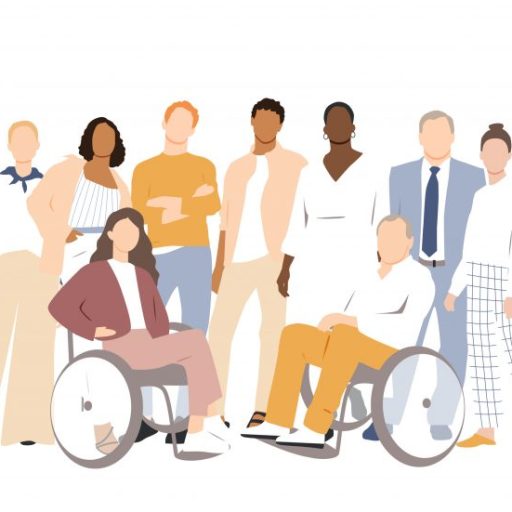By Nick Fortuna
Demographics aren’t destiny, so if the material handling industry and other business sectors want to build a more diverse workforce, it’s going to take a sustained effort.
That’s a message from Kelly McDonald of Denver-based McDonald Marketing, a noted speaker and author on diversity, equity and inclusion (DEI). Over the past few years, McDonald has produced a series of webinars for MHEDA about this topic, encouraging members to increase their outreach to diverse communities if they want to meet their workforce needs.
McDonald points to the U.S. Census Bureau’s diversity index, which measures the probability that two people in the United States chosen at random would be of different races or ethnicities. In 1980, that likelihood stood at only 34 percent, but by 2020, it had climbed to 61 percent, illustrating the rapid diversification of America.
Armed with that data, executives in male-dominated or mostly white industries may believe it’s just a matter of time before their companies become more diverse. But McDonald, whose books include “It’s Time to Talk About Race at Work,” said businesses shouldn’t assume that national demographic changes automatically will result in a more diverse workforce.
“A lot of organizations will say that the wind is at their backs in terms of demographics, so they don’t really need to do anything new, but that’s not true,” McDonald said. “Good workers always have choices, and they’ll choose to work for companies that make them feel welcomed and valued. You can’t assume that talented, diverse candidates are just going to flow to you. You have to go get them.”
McDonald said the concept of shelf-space marketing applies to DEI in the workplace. Just as shoppers can’t buy a product if they don’t see it on store shelves, jobseekers can’t apply for jobs if they don’t have any familiarity with a company or industry. To make inroads in diverse communities, you have to meet people where they are, a task taking on greater urgency as just about every industry struggles with a stubborn national labor shortage.
“The most successful companies are doing massive outreach in their communities and saying very humbly and straightforwardly, ‘We’re not as diverse as we need to be, we’re aware of that, and we’re working to change that,’” McDonald said. “Most of the time, you’ll be greeted with open arms because jobs is the universal language that everyone speaks.”
Casting a Wide Net
American Job Centers, funded by the U.S. Department of Labor’s Employment and Training Administration, are a good place to start. There are almost 2,400 AJCs scattered across the country, providing free help to jobseekers. AJCs have career counselors on staff to help candidates identify their interests, assess their skills and advise them on in-demand jobs and potential training opportunities.
Similarly, local nonprofit groups dedicated to aiding women and minority jobseekers can be found in most communities. If an Internet search yields few results, contact your local department of social services and Chamber of Commerce for help.
McDonald said recruiters should seek to build relationships with career counselors at these groups so that their companies are top of mind when a job candidate is looking for work. MHEDA members should emphasize that the material handling industry has a lot to offer, including career development opportunities, good pay, benefits and a commitment to becoming more diverse.
Companies also should stress that for some positions, no experience is necessary, and there are training programs in place to get new hires up to speed quickly. By offering a robust training program, businesses can hire from a larger pool of workers, including recent high school graduates and college students who need part-time work, McDonald said.
Recruiters should seek out guidance counselors at local high schools and community colleges, offer to be a guest speaker in classes and attend on-campus job fairs as well.
“Entry-level people have to enter somehow, so if there are good jobs where no experience is required, that’s like gold because there are many kids who graduate high school and don’t go on to college or the armed forces,” McDonald said. “Where do they go? They go to work, so why not have more of them come to your company?”
Establishing a presence at community gathering spaces such as the YMCA and minority churches is another best practice. McDonald said she knows of companies that have contacted local Black churches and Catholic churches that offer services in Spanish, asking if they could leave printed materials there and letting them know that they’d like to speak with jobseekers.
“We’re talking feet on the street here,” she said. “This is very grassroots.”
Even if these efforts don’t bear fruit immediately, “you’re planting seeds in your community, and you can’t go wrong doing that,” McDonald said. Many people hear of job opportunities from the people they interact with in their communities, and when we meet new people, one of the first questions we typically ask is, “What do you do?”
Consequently, when MHEDA members become even a little bit more diverse, they can gain a foothold in communities that traditionally have been underrepresented in the material handling industry. As employees from diverse backgrounds share their success stories within their communities, there can be a snowball effect, and companies’ efforts to become more inclusive can gain momentum.
“The more diverse your company becomes, the more your diversity will grow because people will gravitate toward those companies that are proving that they value diversity,” McDonald said. “Word spreads fast, but the seeds have to be planted.”
It Starts from the Top
ProLift Toyota Material Handling, a Louisville, Kentucky-based forklift supplier, is among the MHEDA members striving to become more diverse, according to Sacha Powers, the company’s Director of Human Resources. She said the company and the broader industry tend to have a workforce dominated primarily by white males, and ProLift President Chris Frazee has made it a priority to challenge that.
“We believe that having a diverse workforce gives us a competitive edge, and all of the research out there proves it,” Powers said. “When you have diversity of thought around your conference room table, it’s going to pay dividends in terms of profitability and innovation, and we fully believe that here.”
About two years ago, ProLift launched a diversity steering committee made up of executives, managers and employees who help the company establish DEI goals. One of the first initiatives was to have the company’s 30 executives and senior managers read the book “How to Be an Inclusive Leader,” by Jennifer Brown.
The book covers the four developmental stages of leaders when it comes to DEI – unaware, aware, active and advocate – describing the mindsets and behaviors executives display in each stage. She also lays out “simple steps that will help you understand your role, boost your self-awareness, take action and become a better version of yourself in the process,” according to her website.
Subsequently, ProLift had that same group attend a webinar in which Brown covered topics such as unconscious bias and micro-aggressions – statements or actions that represent indirect or unintentional discrimination against a marginalized group. Often dismissed as offhand comments or harmless jokes, micro-aggressions can eat away at employee morale and send a subtle message that a company doesn’t truly value diversity.
“Our leadership team is completely supportive of our DEI initiatives, and I think that’s really critical,” Powers said. “You’ve got to have support from your top executives. It’s less likely to be successful if it’s only being championed by the HR department. You really need to have buy-in from the top.”
This year, ProLift plans to have its midlevel managers take the same online workshop, Powers said. The goal is to help managers create a workplace where employees and job applicants from diverse backgrounds feel included and valued – a place where they’re allowed to be their authentic selves.
“Sometimes people hide a part of themselves because they’re different, and it’s really important for people to feel accepted for who they are so that they can bring their unique talents to work every day,” Powers said.
Offering Support
Powers said a goal of ProLift’s diversity steering committee last year was to establish a networking and support group for its women employees. Plans for the group include offering training and educational events for members, including women guest speakers who have found success in male-dominated industries.
The group also is exploring ways to partner with Dress for Success, an international nonprofit seeking to empower women by providing them with business attire, networking opportunities and development tools.
“It was an exploratory, fledgling venture last year, and I expect it to grow by leaps and bounds this year,” Powers said of the women’s group at ProLift. “We now have a logo, we have drawn up a charter, and we have budget funds allocated. Creating that camaraderie and fellowship for women at ProLift is a great way to acknowledge and support that population of our workforce.”
ProLift is considering hiring a diversity consultant to identify ways to appeal to a larger pool of jobseekers, Powers said. That effort includes reviewing the language used in job postings to ensure that they don’t contain words that discourage certain jobseekers from applying. For instance, a posting for a sales associate might include phrases like “rock star,” “relentless,” “take-charge personality” and “aggressive,” which may subtly suggest that the company is seeking to hire a man.
“We’re trying to neutralize our job postings and scrub our job descriptions of language that leans toward one gender or the other,” Powers said.
Similarly, McDonald said a phrase like “must have three to five years’ experience” in a job posting can dissuade older jobseekers with many years of experience from applying. A simple tweak would be to say that applicants “must have at least three years of experience,” she said.
“It’s important to look at your job descriptions, dust them off and ask yourself what you could do to make your company more inviting,” McDonald said.
Here are three additional ways companies can show that they value diversity:
Promote diversity online. A company’s website should feature a diverse group of employees and a section devoted to its DEI initiatives, McDonald said. A company’s homepage is one of the first places jobseekers will turn to for information about a prospective employer, so it’s vital that the website reflect the business’s commitment to DEI.
In addition, companies should use their social media accounts to celebrate holidays such as Martin Luther King Jr. Day, Black History Month, National Hispanic Heritage Month, International Women’s Day and LBGTQ Pride Month. Recognizing those holidays both online and in the workplace shows job candidates and workers that the company values diversity, McDonald said.
Have a zero-tolerance policy for demeaning comments. McDonald said managers and their employees should be taught that there’s no place for racist, sexist or homophobic language at the workplace, and violations of this policy will result in punishment, ranging from a verbal warning up to termination.
She said workers should be taught about the bystander effect, which describes a situation where a person hears a demeaning comment directed at a co-worker and is unsure of how to respond. Employees should be encouraged to stick up for those mistreated employees in a professional manner, even if it takes them a while to summon the fortitude.
One way to address such a situation is to speak with each employee privately. Ask the employee who has been insulted if she is OK, and let her know that you don’t condone that type of behavior. Separately, tell the employee who made the comment that you thought it was inappropriate and that if it happens again, you will report it to a manager or human resources, McDonald said.
“A lot of people will freeze in a situation like that because they’re not sure what to do, but it’s never too late to let that person know that you’re an ally, and it’s never too late to confront a bully,” she said.
Have a mentorship program in place. Mentoring new hires and those seeking to advance within the company is an essential component of retaining workers, but such a program is especially important for diverse employees, McDonald said. If candidates from diverse backgrounds don’t feel as though they’re being set up for success, they may leave the company and discourage people in their communities from applying.
“It’s really important to check in periodically with your diverse talent,” McDonald said. “You don’t just hire diverse talent and then check that off your list. You have to take the time to ask them, ‘How’s it going? What can I help you with?’ It’s all about nurturing and training.”
Diversity and Inclusion, by the Numbers
Research shows that diverse companies outperform their competitors. According to a 2019 analysis by McKinsey and Co., companies in the top quartile for gender diversity on executive teams were 25 percent more likely to have above-average profitability than companies in the fourth quartile.
Likewise, the analysis found that companies in the top quartile for minority representation on executive teams were 36 percent more likely to have above-average profitability than companies in the fourth quartile.
Here are some other stats on DEI in the workplace from a 2020 survey by Glassdoor:
• 76% of jobseekers say that a diverse workforce is an important factor when evaluating companies and job offers. That figure is slightly higher for Black (80%), Hispanic (80%) and LGBTQ (79%) jobseekers.
• 47% of Black jobseekers and employees have quit a job after witnessing or experiencing discrimination at work. For Hispanic employees, that figure is 49%, while for white employees, it’s 38%.
• 71% of employees would be more likely to share experiences and opinions on DEI at their company if they could do so anonymously.
• 71% of Black employees and 72% of Hispanic employees say their company should be doing more to increase the diversity of its workforce. Among white employees, that figure is 58%.
• 32% of jobseekers wouldn’t apply to a job at a company where there’s a lack of diversity. For Black jobseekers, this figure is 41%, compared with 30% for white jobseekers. Among LGBTQ workers, that figure is 41%, compared with 32% for non-LGBTQ employees.
• 37% of jobseekers wouldn’t apply to a job at a company where there are disparities in employee satisfaction ratings among different ethnic or racial groups.
• 66% of jobseekers trust employees the most when it comes to understanding what diversity and inclusion really looks like at a company, significantly higher than senior managers (19%), the company’s website (9%) and recruiters (6%).
Technology Companies to the Rescue?
As companies redouble their DEI efforts, a number of tech startups are looking to capitalize on that inclusivity. Among them is Mogul, a New York City-based company that offers a talent acquisition platform, diversity recruiting services, inclusive networking events, educational events and online social communities.
Mogul’s software includes filters that allow recruiters to access more than 430 million diverse candidate profiles and sort them according to demographics such as gender, ethnicity and veteran status.
“Our algorithms offer a more robust and diverse talent pipeline for our clients, which span all industries,” said Tiffany Pham, Mogul’s chief executive and founder.




